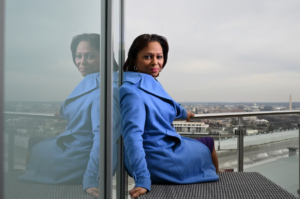Black Women in Meteorology are Shifting TV Field Dominated by White Men
For decades, broadcast meteorology has been dominated by White men — leaving out women, and particularly women of color. Of the hundreds of chief meteorologists at news stations across the country, few are Black women.
Now, Black women are fighting to climb the ladder and claim top meteorology roles. For Veronica Johnson, her journey took nearly 30 years.
When it was time for Johnson to decide what she wanted to do with her life, she chose to be a broadcast meteorologist. She loved weather, but she also wanted to see more people of color talking about science on television.
“Someone has to be the first,” Johnson said in a recent phone interview. “I’m still standing on the shoulders of the few that have come before me.”
In early December, Johnson was named the new chief meteorologist for WJLA (Channel 7), the ABC affiliate for the D.C. area.
But even as Black women like Johnson chip away at long-standing barriers, the path has been a challenge for those often hidden in the world of meteorology. And the data confirms what Black women in the industry have described: they are grossly underrepresented in meteorology — especially in television.
The American Meteorological Society (AMS) found that Black and African American meteorologists made up 2 percent of the entire membership in 2020, the last year it collected data. The ratio of Black men to women is 60 percent to 40 percent — indicating that Black women make up less than 1 percent of members. That data also includes the news industry. The National Association of Black Journalists says there are about 138 Black meteorologists in journalism across the United States. Of Black meteorologists, about 46 percent are women, according to Jason Frazer, NABJ’s weather and climate task force chair.
“While African Americans make up about 13.6% of the US population, they represent only about 5.5% of the Meteorologists you see on television,” Frazer, a meteorologist and co-host for Fox Weather First, wrote in an email. “That is significantly less than the number of Black TV Anchors and Reporters.”
The number of Black women in chief meteorologist positions is “low,” said AMS President Richard Clarke. The society is in the early stages of collecting up-to-date demographic data on its membership. And while no major organization appears to have specific data on the number in the top roles,in interviews with The Washington Post, three Black women serving as chief meteorologists said they knew of just a few others in the United States.
More broadly, a 2018 study conducted by Alexandra Cranford, a TV meteorologist in Louisiana, found women made up just 8 percent of chief meteorologists nationwide.
Johnson, an Emmy-award winning meteorologist, said she was twice passed over for a top position — in 2010 and 2018. Both times, White men got the job. Many meteorologists, she said, get the opportunity to move into a chief role after 5 to 10 years, but Johnson has been waiting for this opportunity for “most of her career.”
